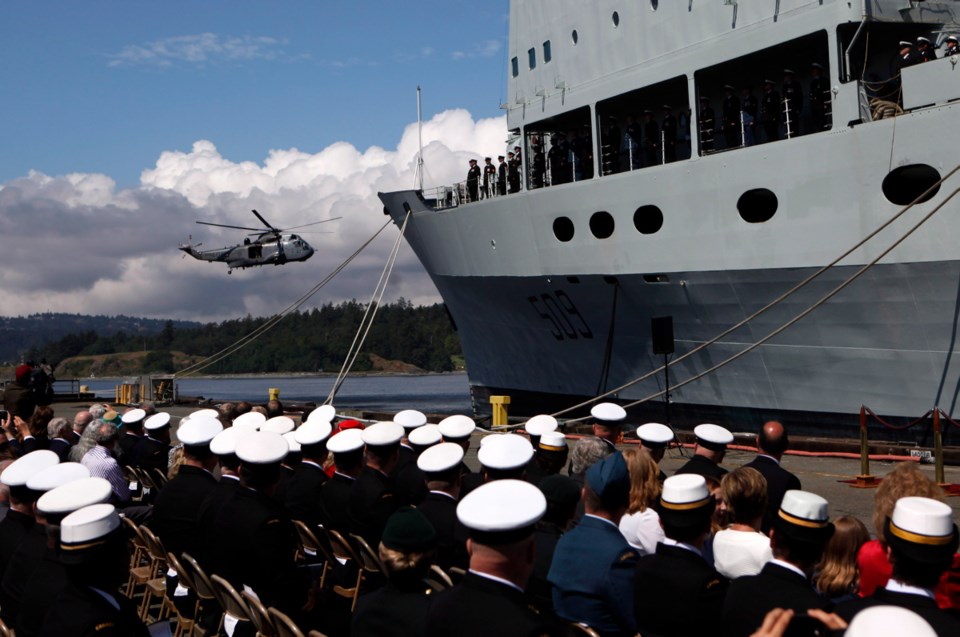As HMCS Protecteur was officially decommissioned at CFB Esquimalt Thursday, a former commanding officer of the key Royal Canadian Navy supply ship worried about the implications of having no military replenishment ships on either coast.
“We as a nation should have been preparing for the loss of these ships years ago,” said Don McClean, who commanded Protecteur between 1990 and 1993, leading the ship into the Gulf War and humanitarian missions.
The Navy announced in September it would retire four warships: one guided-missile destroyer from each coast, HMCS Iroquois and HMCS Algonquin, and both supply vessels, HMCS Protecteur and CFB Halifax-based HMCS Preserver.
The 46-year-old Protecteur suffered critical damage during a fire in February 2014, forcing it to be towed to Pearl Harbor, Hawaii, and then back to Esquimalt. About six months earlier, it sustained damage to its bow after colliding with HMCS Algonquin during a towing exercise while en route to Hawaii.
It was no surprise when the Navy announced in September that Protecteur would be retired, along with the other three other warships.
To underscore the loss, McClean laid out just how important a supply ship can be on a long deployment.
“This ship can take three or four frigates with her and stay at sea for three or four months and give them everything they need, fuel, food, spare parts. I could fix their airplanes with the air deck that I had on board, I could take their airplane and give them a new one while it was on board getting fixed. We have none of that now,” he said. “So it’s a major, major hole in the navy’s capability and it’s going to be there for some years. It’s not good.”
McClean said frigates will have to rely on NATO allies to re-fuel at sea or be forced to go into the nearest harbour.
HMCS Protecteur took part in 40 international military assignments, including a deployment to the Persian Gulf in 1991, a mission to support the relief effort after Hurricane Andrew devastated Florida in 1992, and was part of the multinational task force to assist East Timor from October 1999 to January 2000. In 1982, the ship rescued 28 Norwegian sailors after they were forced to abandon a chemical tanker after a raging fire broke out.
It’s estimated more than 10,000 Canadian Forces personnel served on the ship, which spent a total of eight-and-a-half years at sea, covering over 800,000 nautical miles — enough to circle the Earth at the equator 31 times, said the ship’s final commanding officer Blair Brown.
“If frigates are the eyes, the ears and the hands of the Canadian Navy, surely the Protecteur was the heart of this fleet,” Brown told a crowd of retired naval officers and the crew’s family members gathered for the paying off ceremony. (The term “paying off” dates back to a time when sailors were literally paid the wages owing them as they left the ship to go ashore.)
Peter Campbell, now 88, was in Saint John, N.B. when HMCS Protecteur was commissioned on Aug. 30, 1969, serving as the ship’s first executive officer when it was part of the Atlantic Fleet.
Watching the ship be retired 46 years later was emotional, he said, and it’s a loss that will certainly affect the military’s capability.
“A ship like this reinforces the fleet, the loss is just irreplaceable,” said Campbell, who lives in Victoria. “It's a force multiplier. It doubles and triples the effectiveness of the other ships so they can be at sea three or four times as long.”
The Harper government has announced a $11.3-billion national shipbuilding strategy that includes two joint support ships being built on the West Coast by Seaspan. The contract also includes patrol ships, science vessels, a polar icebreaker and multi-tasked vessels. The work is expected to run for 30 years and create 4,000 jobs in B.C.
Most of the construction will take place in North Vancouver before the ships are brought to the Victoria Shipyards for final trials and testing.
The government has said the first ship will be ready by 2019. But with work just starting, McClean estimated the Navy won’t see a new ship until 2023 or 2024.
“We haven’t started cutting steel yet and when you do it takes six or seven years to build a ship,” he said. “Even when you bring that new ship online, it’s not immediately operational. You have to go through trial periods and get all the equipment working.”
The Canadian Navy has not announced detailed plans for replacing the decommissioned ships until the new patrol ships are built.
A spokesperson from the Department of National Defence said Thursday the Navy “is currently studying all options for an interim solution.”
In September 2014, Vice Admiral Mark Norman, commander of the Royal Canadian Navy, said those options “include potential enhancements, or additions, to existing agreement with key allies, as well as some made-in-Canada solutions.”
— With files from The Canadian Press



